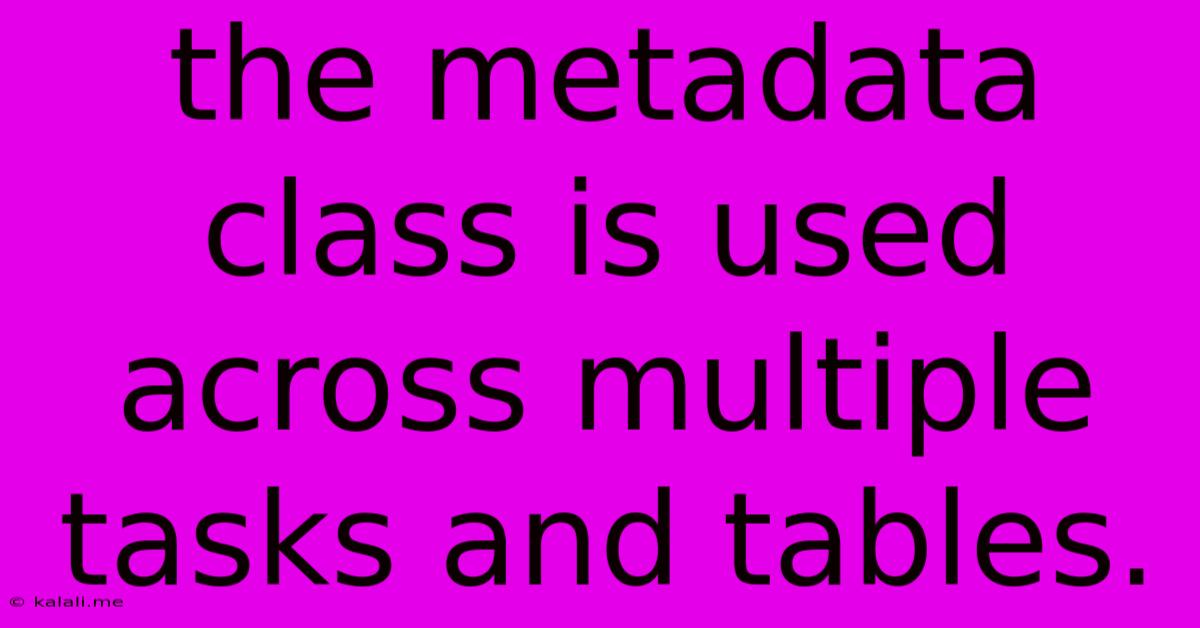The Metadata Class Is Used Across Multiple Tasks And Tables.
Kalali
Jun 05, 2025 · 3 min read

Table of Contents
The Metadata Class: A Powerful Tool for Data Management Across Multiple Tasks and Tables
The efficient management of metadata is crucial for any application dealing with large datasets or complex data structures. A well-designed metadata class can significantly improve data organization, searchability, and overall maintainability. This article explores the benefits and implementation considerations of utilizing a metadata class across multiple tasks and tables within a database or application. This approach streamlines data handling, enhances data integrity, and simplifies complex operations.
What is a Metadata Class?
A metadata class is a structured way of storing information about data, rather than the data itself. Think of it as a descriptive catalog or index. It typically contains attributes such as data type, source, creation date, modification date, owner, and any other relevant information that provides context and meaning to the underlying data. This contextual information is invaluable for effective data management. For instance, imagine tracking the origin and processing steps of a specific image within a large image database; metadata provides that crucial lineage information.
Benefits of a Centralized Metadata Class Across Multiple Tasks and Tables
Using a single, well-defined metadata class offers several compelling advantages:
-
Consistency and Standardization: A centralized class ensures consistent metadata across all tables and tasks, eliminating inconsistencies and improving data quality. This is particularly valuable in large collaborative projects where multiple developers or teams might access and modify data.
-
Improved Data Discoverability and Searchability: Comprehensive metadata makes it significantly easier to find and retrieve specific data based on various criteria. This enhances efficiency and reduces the time spent searching for relevant information. Imagine needing to find all images processed by a specific algorithm – metadata makes this a simple query.
-
Simplified Data Integration: When metadata is consistent and standardized, integrating data from various sources becomes simpler and more reliable. This is crucial for applications that rely on data from different databases or systems.
-
Enhanced Data Governance and Compliance: A well-structured metadata class simplifies data governance by providing a central repository for tracking data lineage, access controls, and compliance requirements. This is especially important in regulated industries where data provenance is vital.
-
Reduced Redundancy: Centralizing metadata avoids the need for storing the same information repeatedly across different tables, reducing storage space and improving data consistency.
-
Facilitated Data Analysis and Reporting: Rich metadata provides context for data analysis and reporting, enabling more insightful interpretations and more accurate reports.
Implementation Considerations
Implementing a robust metadata class requires careful planning and consideration:
-
Schema Design: Design a flexible and extensible schema that can accommodate the evolving needs of your application. Consider using a database-agnostic approach to ensure portability.
-
Data Relationships: Define clear relationships between the metadata class and the underlying data tables. This typically involves foreign key relationships or similar mechanisms.
-
Data Validation: Implement robust data validation to ensure data integrity and prevent errors. This could include data type validation, range checks, and other constraints.
-
Version Control: If metadata changes over time (e.g., updates to data descriptions), implement version control to track changes and maintain audit trails.
-
Scalability: Design the metadata class to scale effectively as the size of your dataset and the complexity of your application grow.
Conclusion
The implementation of a well-structured metadata class across multiple tasks and tables offers significant benefits for data management, improving data quality, consistency, and searchability. By carefully considering the implementation details and adopting a robust schema design, you can leverage the power of metadata to streamline your data handling processes and enhance the overall efficiency and maintainability of your application. The long-term value and enhanced data governance capabilities make this a worthwhile investment for any project handling substantial data volumes.
Latest Posts
Latest Posts
-
Mac Delete Folder In Libraray Operation Not Permitted
Jun 06, 2025
-
When Does Rimuru Become A Human
Jun 06, 2025
-
What Does It Mean When Someone Says Beas
Jun 06, 2025
-
Does Super Glue Work On Plastic
Jun 06, 2025
-
Is It Me Neither Or Me Either
Jun 06, 2025
Related Post
Thank you for visiting our website which covers about The Metadata Class Is Used Across Multiple Tasks And Tables. . We hope the information provided has been useful to you. Feel free to contact us if you have any questions or need further assistance. See you next time and don't miss to bookmark.